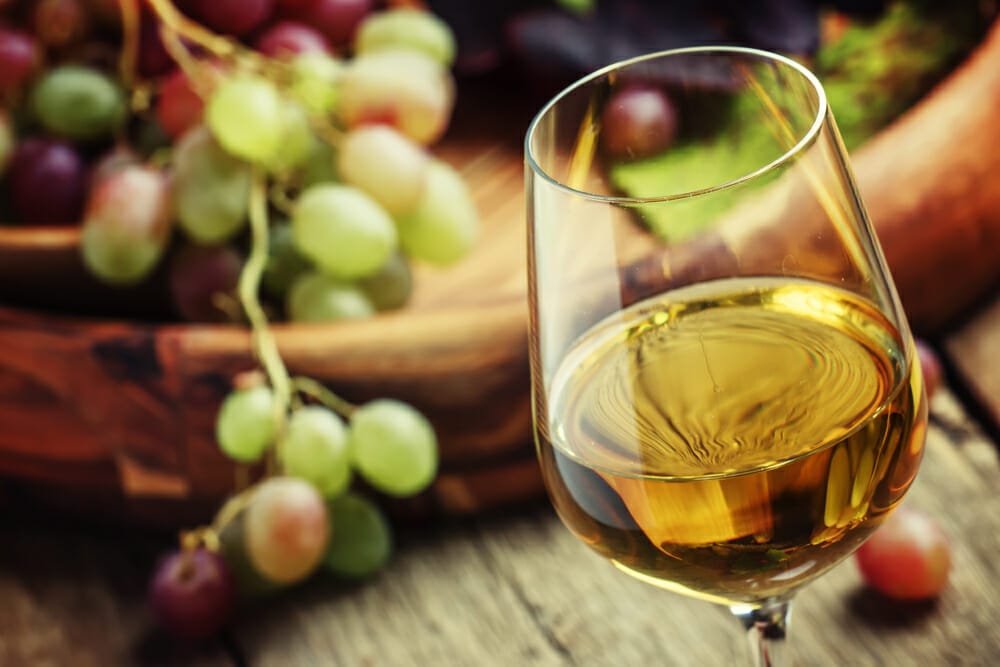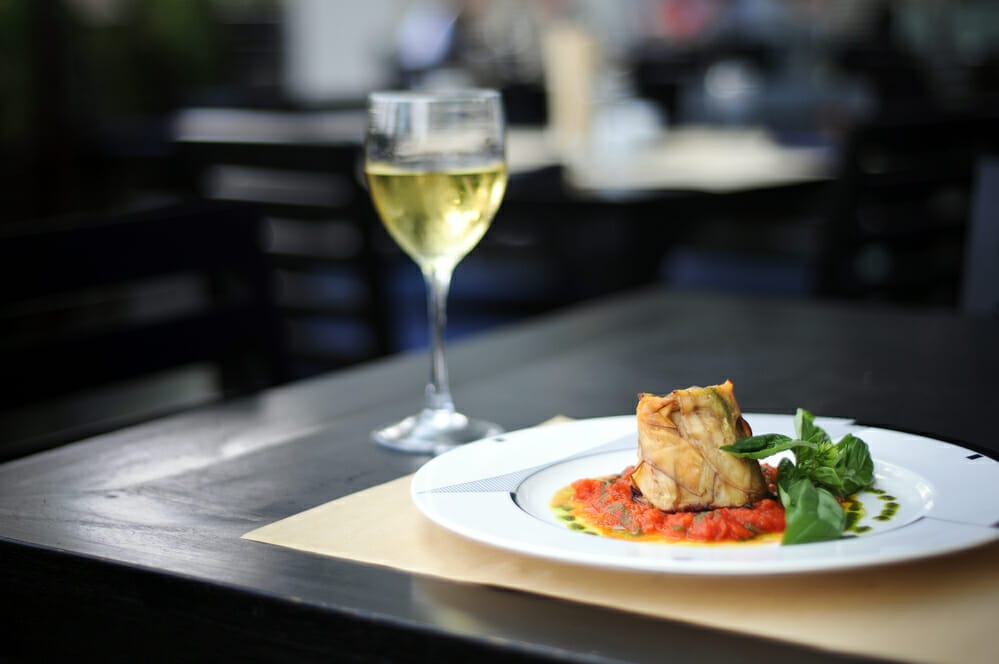If you’re a white-wine newbie, Chardonnay might seem like a mystery. It changes between every bottle and reaches every corner of the wine flavor spectrum, making it endlessly versatile.
One of the most common questions is whether Chardonnay is sweet or dry. This can be a bit complicated!
In short, Chardonnay is a dry wine that may taste sweet, depending on the methods of its winemaker and the environment the grapes grow.
In this article, we’ll break down all the specifics of Chardonnay, including:
- How it tastes, and whether it’s sweet or not
- How you can find the perfect Chardonnay for your tastes.
By the end, you’ll be able to choose your next bottle with confidence. Let’s get into it!
Chardonnay: The Basics

What is Chardonnay?
First grown in Burgundy, France, Chardonnay grapes have become one of the most popular wine grapes in the world.
They’re often called “winemaker’s grapes”. This is because they’re greatly impacted by the environment they’re grown in, when they’re harvested, and how they are processed into wine.
Tasting Notes
Chardonnay can be anything from full-bodied and fruit, to fresh and acidic. No matter your tastes or preferences, you can almost certainly find something to love in a Chardonnay.
Generally, a Chardonnay will have fruit-forward notes with a medium-to-full body and low acidity.
From this base, countless flavors may develop depending on factors like climate and aging methods. Just a few possible flavor notes found in Chardonnay include vanilla, tropical fruit, honeysuckle, cucumber, mint, baking spices, chalk, minerals, and mushrooms.
The Wine Sweetness Scale: Is Chardonnay Sweet?
The sweetness of wine is measured on something called the sweetness scale. On the opposite side of sweet, wines are called “dry”.
Sweetness is measured not based on the final taste, but on how much sugar residue is left in the container once the wine has finished fermenting.
| Name | Sugar p/ liter | Examples |
| Bone Dry | Less than 1g | Muscadet, Brut Nature |
| Dry | Less than 10g | Chablis, Pinot Gris, Sauvignon Blanc, Viognier |
| Off-Dry | 10g – 35g | Early Harvest Riesling |
| Sweet | 35g – 120g | Late Harvest Riesling, Barsac, Sauternes, Muscat |
| Very Sweet | More than 120g | Sherry, Ice Wine |
On this scale, Chardonnay is generally considered a dry wine. It leaves very little sugar residue in the barrel after fermenting.
Many people don’t realize this classification because, with certain flavor notes, Chardonnay can taste fairly sweet.
What Makes Chardonnay Sweet or Dry?

Soil and Climate
Chardonnay is greatly impacted by the environment it’s grown in.
Generally, this is most related to the soil and climate of its vineyard. Chardonnay grapes can survive in a huge range of climates, and therefore experience a large gradient of flavor profiles.
When grown in very calcium-rich soil, Chardonnay grapes will gain a subtle briny note, as well as hints of chalk. Some soils may also produce a mineral-like flavor.
In warm climates, they gain tropical fruit flavors such as pineapple, papaya, guava, yellow peach, banana, and passionfruit. They also gain a higher alcohol content.
Grown in cooler climates, the grapes will take on more acidic, crisp, and citrusy notes. Flavors like lemon, lime, and grapefruit. Cool-climate Chardonnay will also tend to be lighter-bodied.
Harvest Timing
When the grapes are left on the vine longer before harvesting, they have a chance to develop more sugar and lose acidity.
Early-harvest Chardonnay will normally have more acidic, light, and crisp qualities, whereas late-harvest grapes will produce fruity, tropical, and full-bodied flavors.
Oak Aging vs Stainless Steel Aging
Oak-aged wine has been fermented or aged in a traditional, oak barrel, rather than a stainless-steel tank. This method means the wine comes into contact with the wood and “absorbs” some of its flavors.
While wine ages in a barrel, it’s also exposed to tiny amounts of air, unlike when in an air-tight steel container. This produces new flavor profiles depending on the environment.
Oak aging will introduce fruity and full flavors, making wine taste sweeter. In comparison, unoaked Chardonnay will be much crisper, with light, acidic, and fresh flavors.
The type of oak used will also impact the final flavors, with certain oaks introducing notes of vanilla or toasted bread.
Malolactic Fermentation (MLF)
This is a process that only occurs in oak-aged wine, sometimes naturally, and sometimes because it’s been encouraged by the wine-maker.
In simple terms, a bacteria called Oenococcus Oeni converts tart malic acid into a rounder, softer lactic acid.
This will change the flavor notes of the wine from sharp and acidic to smooth, creamy, buttery, and soft. The longer this process occurs, the more intense its effect.
Pairing Chardonnay With Food

The great thing about Chardonnay’s versatility is that it goes with almost any food you can imagine, so long as you pick the right bottle.
Your main focus should be matching the weight of the food with the weight of the wine.
For example, heavy, creamy pasta or grilled meat will go best with a full-bodied, oak-aged wine. In comparison, lighter food like sushi or shellfish will go wonderfully with a light and acidic Chardonnay.
Most Chardonnays are great accompaniments for seafood, with well-matched flavor notes. Mushrooms are another excellent match, as well as cheeses like gruyere or gouda (with medium to full-bodied wines).
How to Find the Perfect Chardonnay for You
Explore Different Chardonnay Regions
Chardonnay is grown in every major wine-making country in the world. Some of the best producers include California, USA; Yarra Valley, Australia; and, of course, its origin, Burgundy, France.
Within each country, wine will vary depending on local microclimates and aging style.
Consider Your Preferred Flavor Profile
Think about wines you already enjoy and what flavor profile they have.
If you normally enjoy sweet, full-bodied wines and notes like vanilla or fruit, you should look for an oak-aged, late-harvest Chardonnay.
On the other hand, if you like acidic, light, and fresh-tasting wine, you should look for an unoaked, early-harvest Chardonnay from a cooler climate.
Try Various Vintages to Find Your Preferred Aging Style
Keep in mind the aging styles such as oaked vs. unoaked, or whether malolactic fermentation (MLF) is used.
Oaked wines will be more alcoholic, with fruity, full, deep, and heavy flavors. Unoaked wines will be light, acidic, and fresh, often with notes of lemon or grapefruit.
If MLF is utilized, the wine will be creamy, buttery, and smooth. This is great for pairing with heavy foods like carbonara (or even mac and cheese!).
Taste Chardonnays With Diverse Food Pairings
What’s so wonderful about Chardonnay is that it goes with almost anything.
There are some rules – but as long as you pair the heaviness of the food with the weight of the wine, you should be good to go!
Experiment with your food and Chardonnay pairings. You may just find something incredible.
Attend Wine Tastings and Seek Recommendations
This is the absolute best way to discover the right wine for you.
Of course, buying so many bottles yourself is unrealistic and can take a long time. This is where wine tastings are great. Even better, they make a great day out with friends.
You should also take advantage of the highly knowledgeable staff at wine tastings, who can give you some excellent recommendations based on your existing preferences and guide your experience.
Trust Your Palate and Personal Preference
This is the number one rule of wine.
Though some wines are much more expensive than others, ultimately, wine is meant to be enjoyed. The most important thing is that you like what you’re drinking.
Don’t avoid or choose specific wines based only on public opinion if it goes against your tastes.
Trust your taste and know your preferences, and you’ll get the most out of your wine.
FAQs
No. Chardonnay is usually considered a dry wine because it leaves very little sugar residue behind after fermentation. However, this can change greatly depending on where and how it’s produced. Some Chardonnays taste very sweet, with strong fruity notes.
Both are considered quite dry wines, leaving very little sugar residue behind after fermentation. Chardonnay is normally dryer (less sweet) than Pinot Grigio. However, this is a minor difference, and can vary between specific bottles. You can read more about their head to head comparisons here.
Both Chardonnay and Sauvignon Blanc are considered quite dry wines due to the small amount of sugar residue left behind after their fermentation. Because they are so close, the sweetest of the two depends entirely on the specific bottles being compared.
Oak-aged, late-harvest Chardonnay grown in a warm climate will be the sweetest form. These wines will usually have notes of tropical fruit, such as pineapple or guava. They also tend to have a buttery, smooth mouthfeel thanks to oak barrel fermentation processes.
This depends entirely on your preference. Both can be excellent wines.
Chardonnay will normally have more citrusy, herby flavors and a fresh flavor. In comparison, Sauvignon Blanc generally has melon and autumn orchard fruit notes – sometimes leaning into tropical fruit flavors.
If you want a sweet white wine, you should always look for oak-aged, late-harvest wines from a warm climate. Some examples include Riesling, Moscato d’Asti, Sauternes, Tokaji, and Ice Wine. The best method is to try as many kinds as you can to find your favorite flavor notes.
- Moscato vs Roscato: A Comprehensive Comparison of Sweet Wines - December 15, 2023
- Should White Wine Be Chilled? Expert Insights on Serving Temperature - December 14, 2023
- Moscato vs Riesling: A Sweet Wine Showdown - December 8, 2023






![Moscato vs. Chardonnay: 10 Key Differences [2023] Moscato vs Chardonnay](https://e25kn4v6x6d.exactdn.com/wp-content/uploads/2023/09/Moscato-vs-Chardonnay.jpg?strip=all&lossy=1&resize=150%2C150&ssl=1)



